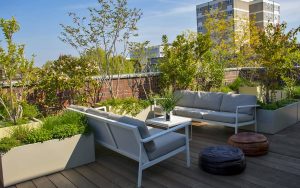Imagine stepping into a world where the boundaries between indoors and outdoors blur, and nature seamlessly intertwines with modern architecture. Picture yourself strolling through lush gardens, surrounded by vibrant flowers and towering trees, while enjoying the comforts of a luxurious terrace. Welcome to the enchanting realm of Garden Terrace – a concept that brings the beauty of nature right to your doorstep. In this article, we will uncover the secrets behind Garden Terrace and explore how it is redefining the way we experience outdoor spaces.

Concept And Purpose
Exploring the concept and purpose of a garden terrace can be both an enriching and transformative experience. At its core, a garden terrace is a space designed to bring together the beauty of nature and the functionality of outdoor living. It serves as an extension of one’s living space, creating an intimate sanctuary where individuals can relax, entertain, and connect with the natural world.
The purpose of a garden terrace goes beyond mere aesthetics; it offers an opportunity for individuals to reconnect with nature in urban environments. In fast-paced cities where green spaces are limited, these terraces provide a much-needed retreat from the hustle and bustle of daily life. Setting foot on even a small garden terrace allows us to escape into our own personal oasis—a place where we can find solace amidst natural elements such as plants, flowers, birdsong, or the gentle rustling of leaves in the wind.
Design And Elements:
When it comes to designing a garden terrace, there are several key features and components to consider in order to create a captivating outdoor space.
- One of the most important design elements is the layout and arrangement of plants and flowers. The selection of plants should not only complement each other in terms of colors and textures but also be well-suited for the specific climate and conditions of the area.
- In addition to plants, furniture is another essential element that helps define the overall aesthetic of a garden terrace. From cozy lounge chairs to sleek dining sets, choosing furniture pieces that are both comfortable and stylish can greatly enhance the overall appeal of the space. Moreover, incorporating various textures such as natural wood or metal can add visual interest to an otherwise plain terrace.
- Furthermore, lighting plays a crucial role in highlighting the design elements and setting the desired ambiance in a garden terrace. Incorporating different types of lighting fixtures including string lights, lanterns or path lights can create magical effects during evening hours while adding a touch of coziness.
By carefully considering these key features and components during the design process, you can transform your garden terrace into an inviting oasis that combines aesthetic appeal with functionality. Whether you aim for a contemporary look or aim for something more rustic, it’s important to strike a balance between different elements so they work harmoniously together enhancing your outdoor experience.

Plants And Flowers:
When it comes to creating a thriving garden terrace, the choice of plants and flowers plays a crucial role. While many factors need to be considered, such as sunlight exposure, weather conditions, and available space, there are several suitable options worth exploring. One popular choice is the vibrant geraniums. With their wide range of colors and easy care requirements, they can add a burst of color to any garden terrace.
For those seeking low-maintenance options that thrive in various environments, succulents are an excellent choice. These drought-resistant plants come in a variety of shapes and sizes and require minimal watering. Their unique textures and ability to store water make them not only visually appealing but also practical for busy individuals.
Another option to consider is ornamental grasses. Whether you prefer tall grass varieties or more compact options like fescue or blue oat grass, these plants can add movement and softness to your garden terrace design. They require periodic watering but are generally low-maintenance overall.
Maintenance Tips:
Regular maintenance is essential to keep your garden terrace in tip-top shape and maximize its longevity. Here are some key tips to help you ensure proper upkeep.
- First and foremost, it’s vital to regularly inspect your terrace for any signs of damage or wear and tear. Look out for cracks, loose tiles, or missing grout that could potentially lead to more significant issues if left unattended.
- In addition to visual inspection, it’s crucial to clean your garden terrace properly. Use a mild detergent solution and a stiff brush to scrub away dirt, moss, and algae buildup. Regularly sweeping away debris and fallen leaves will also prevent clogging in drains or gutters that may affect the overall drainage system of your terrace.
- Lastly, consider sealing your garden terrace on a regular basis to protect it from moisture damage. This will help maintain its appearance as well as create a barrier against potential water penetration, reducing the chances of cracks or other structural issues over time. By following these maintenance tips diligently, you can extend the lifespan of your garden terrace while also enhancing its aesthetic appeal year-round.
Conclusion:
In conclusion, garden terraces hold immense significance in modern landscape design and environmental sustainability. Firstly, these elevated platforms serve as a sanctuary for nature lovers seeking solace amidst the chaos of urban living. The harmonious coexistence of green spaces and concrete structures not only creates a visually appealing landscape but also promotes mental well-being by providing an escape from the city’s fast-paced lifestyle. By incorporating plants and trees into terrace gardens, we can improve air quality and reduce pollution levels, thus contributing to a healthier environment.
Moreover, garden terraces play a vital role in mitigating the adverse effects of climate change. In densely populated areas where ground space is limited, vertical gardens on rooftops help counteract urban heat island effects by absorbing excess heat and enhancing natural cooling mechanisms. Additionally, these green spaces act as carbon sinks by absorbing greenhouse gases such as carbon dioxide and releasing oxygen through photosynthesis.
Furthermore, garden terraces offer numerous practical benefits beyond their aesthetic appeal. From growing fresh produce to creating additional recreational spaces or even serving as rainwater harvesting systems, there is no shortage of possibilities for maximizing the potential functionality of these elevated gardens.
In conclusion, garden terraces have emerged as an innovative solution to various challenges posed by urbanization. They not only beautify our surroundings but also contribute to our physical and mental well-being while combating climate change. By embracing this concept on a larger scale, we can create sustainable cities that prioritize both human needs and environmental conservation






Be First to Comment